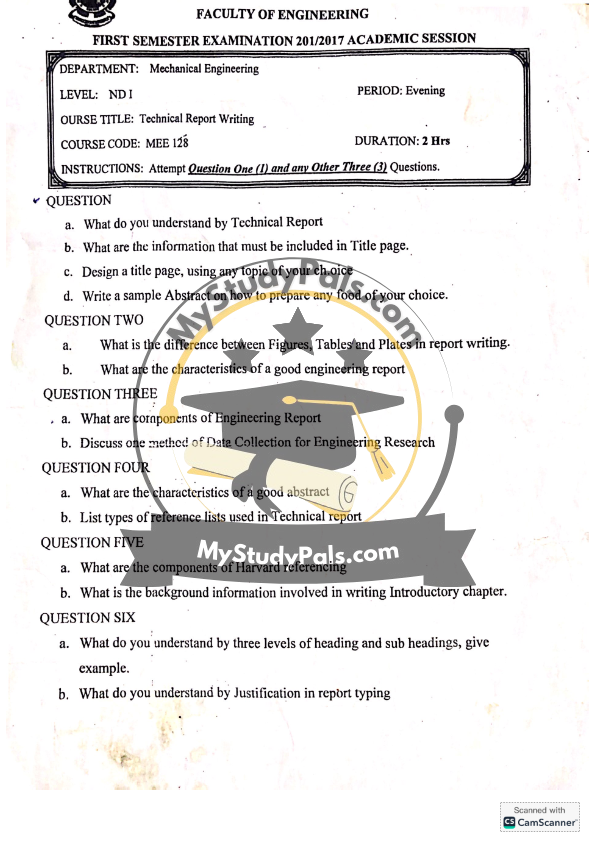 ANSWER
ANSWER
Question 1:
a. A technical report is a structured document that presents research, analysis, or findings on a specific technical subject. It is commonly used in engineering, science, and business fields to communicate complex information clearly and concisely.
b. The information that must be included on a title page includes:
- Title of the report
- Name of the author(s)
- Course code and title (if applicable)
- Institution/Organization name
- Date of submission
- Instructor’s/Supervisor’s name (if required)
c. (Example of a title page design for a report on “The Impact of Renewable Energy on the Environment”)
Title: The Impact of Renewable Energy on the Environment
Author: John Doe
Course Title: Technical Report Writing
Course Code: MEE 128
Institution: Osun State Technical College
Date: March 2025
d. Sample Abstract on “How to Prepare Fried Rice”
Abstract:
Fried rice is a popular dish that combines cooked rice, vegetables, and protein with seasonings. This report explains the step-by-step process of preparing fried rice, including ingredient selection, preparation, and cooking techniques. The key steps involve boiling the rice, stir-frying vegetables and proteins, adding seasonings, and combining all ingredients. The report also highlights the nutritional benefits and variations of fried rice preparation. The method ensures a delicious and well-balanced meal suitable for various occasions.
Question 2:
a. Difference between Figures, Tables, and Plates in Report Writing
- Figures refer to visual representations such as graphs, charts, and diagrams. They illustrate data trends and relationships.
- Tables organize numerical or textual information in rows and columns for easy comparison.
- Plates are typically full-page illustrations, photographs, or detailed drawings used to provide additional visual support.
b. Characteristics of a Good Engineering Report
- Clarity and conciseness
- Well-structured format (Title, Abstract, Introduction, Methodology, Results, Conclusion)
- Use of accurate and relevant data
- Proper referencing and citations
- Logical flow and coherence
- Inclusion of technical illustrations and figures
Question 3:
a. Components of an Engineering Report
- Title Page
- Abstract
- Table of Contents
- Introduction
- Methodology
- Results and Discussion
- Conclusion and Recommendations
- References
- Appendices (if necessary)
b. One Method of Data Collection for Engineering Research
- Surveys and Questionnaires: This involves collecting data from a targeted group of respondents using structured questions. It is useful for gathering opinions, behaviors, and quantitative data related to engineering studies.
Question 4:
a. Characteristics of a Good Abstract
- Concise and informative
- Clearly states the purpose of the study
- Summarizes key findings and conclusions
- Avoids unnecessary details
- Uses simple and precise language
b. Types of Reference Lists Used in Technical Reports
- Books
- Journal articles
- Conference papers
- Technical reports
- Government publications
- Websites and online sources
Question 5:
a. Components of Harvard Referencing
- Author(s) name
- Year of publication
- Title of the work
- Publisher
- Page number (if applicable)
- DOI or URL for online sources
b. Background Information in an Introductory Chapter
- Definition and explanation of the research topic
- Context and relevance of the study
- Objectives and research questions
- Scope and limitations of the study
- Previous studies and literature review summary
Question 6:
a. Three Levels of Heading and Subheadings (with Examples)
- Level 1 Heading (Main Section): Large, bold text (e.g., “3.0 Methodology”)
- Level 2 Heading (Subsection): Bold or italicized (e.g., “3.1 Data Collection Methods”)
- Level 3 Heading (Detailed Subsection): Normal text with underlining or smaller font (e.g., “3.1.1 Survey Techniques”)
b. Justification in Report Typing
- Justification in report typing refers to the alignment of text within the document. It ensures that text is evenly distributed between margins. Common types include:
- Left Justified: Text is aligned to the left margin (common for reports).
- Right Justified: Text aligns to the right margin.
- Fully Justified: Text is evenly spaced across the entire width of the page, creating a neat appearance.

